This July, officials gathered on Fourth and Oak streets in Old Louisville to launch a streetscape improvement project three years in the making that they hope will signal a turning of the tide of the fledgling commercial corridor. The nearly $500,000 project added new landscaping and poured new concrete-and-brick sidewalks between Garvin Place and Third Street.

The Streetscape Design and Goals
“This project will help jumpstart plans to revitalize an area that is one of the great treasures of Louisville,” Mayor Greg Fischer said at the groundbreaking ceremony in July. He added that he hoped the streetscape would “enhance connections with the downtown area to the north, and the University of Louisville and Churchill Downs to the south.”
Further, according to a statement from Metro Councilman David James’ office, the project’s “goal is to transform the Oak Street corridor into a local destination that serves the daily shopping and dining needs of the surrounding neighborhood, and also cater to visitors to Old Louisville from other Louisville neighborhoods and from other cities.”
Those are lofty goals for the new sidewalk.

Plans for the streetscape project date back to 2011, when James created the Fourth & Oak Street Task Force to address issues of safety and lack of retail development that have long-plagued the corridor. The task force members include Andrew Owen (Chair), Joan Stewart, Chuck Anderson, Steve Vice, Tim Hyland, John Fischer, Verna Goatley, Marita Willis, Kim Kraesig, Howard Rosenberg, Derrick Moore, and Bill Holladay.
Much of the new street was complete on my visit in mid-October, with a few trees still missing, and by all accounts the street does look good. The welcome investment in public infrastructure makes the corridor look tidy and well-tended. “This is a new day in the future of Oak Street,” James optimistically proclaimed this past summer. And with retailers filling two new old-fashioned facades applied to commercial buildings next to the perennial Rudyard Kipling on the south side of the street, it looked like Oak Street was open for business.
The streetscape packs some green infrastructure muscle, too. As we like to say on Broken Sidewalk, no single thing in a city should have a single function. The addition of more porous surfaces and tree wells along Oak Street dually helps offset combined sewer overflows caused by excess stormwater runoff, a problem we profiled recently here. Louisville’s Metropolitan Sewer District (MSD) estimated earlier this year that the improvements could “capture…nearly 1 million gallons [of water] in a typical rainfall year.”

Existing Strengths of the Oak Street Corridor
But the reality on the ground is that Old Louisville’s commercial heart still needs help. The neighborhood has some amazing strengths going for it—most notably its density, central location, access to transit, and plentiful existing building stock. But here at Fourth and Oak—what’s intended to be the most prominent intersection in the neighborhood—a number of major missing teeth are hampering development goals.
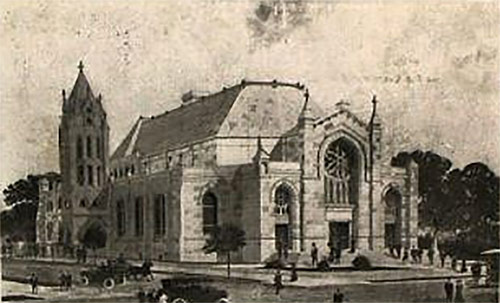
Fourth and Oak is anchored by a beautiful stone church—the old Fourth Avenue Baptist Church that now houses the Louisville Church of Christ—on its southeast corner. The large church with its chamfered corners, prominent Mansard roof, and rounded steeple set at the back of the building gives the intersection a sense of gravity and history. It’s rose-windowed Fourth Street facade features a deep setback that aligns with houses to the south while its Oak Street frontage carries a distinct urban edge that engages the sidewalk with a strong Gothic-arched portico.
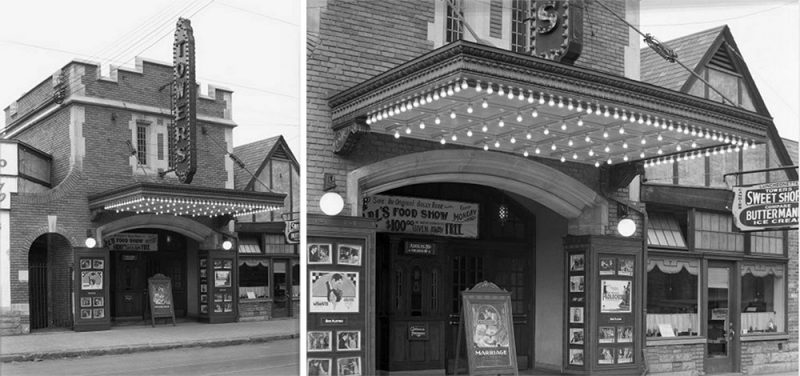
To the north of the church, another architecturally significant-though-downtrodden early-20th century commercial building limps on today a shadow of its past self. Set off the corner next to a nondescript although contributing one-story commercial space, the Tudor building includes a half-dozen storefronts.
Half a century ago, however, the anchor tenant of the building was the Knox Theater, originally the Towers Theater. While the main entrance still exists, today boarded up, the old theater hall is long destroyed. As you’ll see in the aerial views below or if you’ve ever explored the alley behind it, the guts of that building are now a gravel parking lot that often houses school buses and vans. Restoring this building and its theater could make it a real anchor landmark for the area, drawing in visitors from around the city.

The other two corners are slightly more troublesome. On the southwest side, a one-story bank historically prone to robbery sits surrounded by surface-level parking. While the building at least recognizes that it’s on the corner of an urban block, the overall site, including a drive-through, lacks any kind of urban character at all. The parcel does present a good opportunity for dense, infill development—which we recently demonstrated is economically the city’s best option—that could include a bank branch in addition to other retail space and a few floors of offices or residences. We’re trying to create a walkable neighborhood, after all, so we’ll need a little more density.
[beforeafter]
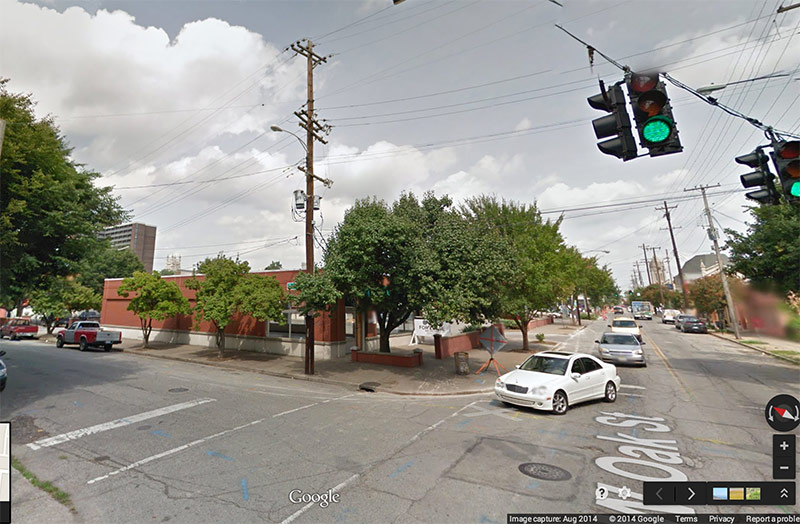 [/beforeafter]
[/beforeafter]
Above: Current view of the northeast corner of Oak Street and Garvin Place courtesy Google, historic view from the late 1960s courtesy UL Photographic Archives – Reference.
The bigger problem—and bigger opportunity—is an expanse of strip mall–style buildings on the north side of Oak Street stretching from Fourth Street to Garvin Place that would feel right at home off Hurstbourne Parkway. The so-called Winn-Dixie block, site of a failed big-box grocery store set mid-block behind a sea of parking, has been abandoned for years, casting a cold (and pretty sketchy) shoulder onto Garvin Place. Closer to Oak Street, a Rite Aid at least offers neighborhood conveniences and a pharmacy, but its urban form is an obstacle to all those not in a car.
Coincidentally, that same corner at Fourth and Oak housed Taylor’s Drug Store years ago behind a neat enameled facade and neon sign. The predecessor pharmacy, however, played along with the urban pattern despite its short stature. Elsewhere on the block, larger commercial buildings and warehouses once stood (see before-and-after above).

Proposals from the Neighborhood Plan
The Old Louisville Neighborhood Plan, put together in 2000, recognized these deficiencies in this block, calling for infill development to anchor the corner, as seen in diagrams above and below. Among the goals of that plan:
Create a pedestrian-oriented neighborhood commercial district at Fourth and Oak. The Task Force recommends that zoning be adopted for each sub-district that would reinforce the dominant uses characteristic of each area. To promote the viability of neighborhood- serving businesses, the Task Force proposes that commercial retail use be the sole permitted street level use with a mixture of uses (office, residential, etc.) permitted on upper floors. Furthermore, the Task Force recommends that all new development within the commercial center have a “zero setback” from the sidewalk, in order to re-establish the street presence and intimacy of an urban commercial district.

The rough schematics above show a simple two-story massing of what would be allowed under Old Louisville’s development rules, but today we should aim for a more ambitious scheme that includes a well-thought-out master plan and higher density. The two-story massing on the corner could be easily expanded to four or five stories with setbacks without any negative impacts to the neighborhood. On the contrary, the density this block could accommodate would go a long way toward supporting the kind of retail the neighborhood needs.
Today’s Oak Street is very different from the Oak Street of 15 years ago. Back then, the area was generally regarded as a seedy and crime-ridden—surely one of the unspoken goals of this recent streetscape project was an attempt to put those perceptions finally to rest. And at least some of the 2000 neighborhood plan’s vision has already been implemented: Oak Street has been converted to a two-way street.
Real Transit Needed for Success
But for the Oak Street streetscape project to meet the last lofty goal set forth by the Mayor and Metro Councilman—that the corridor increase connectivity to Downtown and the University districts to the north and south—Louisville’s public- and private-sector leadership must step up and embrace modern transit such as a modern Fourth Street streetcar line like the one we recently discussed here on Broken Sidewalk. In other cities, investing in such transit lines with tracks in the ground has helped give confidence to developers who might invest in the scale of projects it will take to redevelop the Winn-Dixie block.
Even 15 years ago, the prospects for improved transit were better than today. Then, the T2 Light Rail system was still being planned on a north-south route that included the Oak Street corridor. The neighborhood plan called for capitalizing on this: “The Task Force recommends a corridor improvement strategy along Oak Street that links the Neighborhood Center with the future light rail stop at Preston and Oak Streets.” Today, with our downtown’s urban fabric shredded by billions in highway construction, none of city’s leaders is even talking seriously about transit in Louisville.
What’s a Streetscape Good For?
Finally, can a streetscape project really ever bring about the intended results that warrant the investment? It’s an important question considering Louisville’s past tendency to redo a streetscape and announce that the corridor is renewed only to have the underlying problems persist. Consider hefty investments on East Main Street near Slugger Field where an improved streetscape—an aesthetically appealing one it should be noted—continues to fall apart from poor maintenance, improper installation, and neglect. The sidewalk across Main Street from the ballpark where the old D&W Silks building was regrettably torn down, for instance, has been strewn with gravel and weeds from the parking lot that replaced the 19th century warehouse. More recently on Fourth Street, a new streetscape has certainly improved the aesthetics of the corridor, but retail there remains one of Louisville’s biggest challenges.
On Oak Street, large trees were removed to build the new sidewalk, as seen in the views above. While this may have been required for some reason, the trees that will replace them will take years to reach that size again. Yet on the south side of the street, the above-ground power lines that cause major problems during storms still tower over the streetscape precluding Oak Street from ever being lined with actual Oak trees. The new streetscape will surely boost consumer and retailer confidence, but it will likely do nothing to address the larger need for redevelopment in the area we discussed above.
Oak Street’s Best Days Ahead
Today, however, the Oak Street corridor’s future is looking up. New retailers including a BBQ joint have filled the renovated storefronts on the south side of the street. The Rudyard Kipling, a restaurant, bar, and music venue known locally as the Rud, has watched over the street’s evolution for decades. The Rud, one of my own favorite spots in Louisville, is still going strong with new owners announced at the end of last year.
As the sun was setting on my walk around Oak Street, a man popped out of a corner commercial building on the northwest corner of Oak and Garvin (pictured above) to let me know that a new cake shop and bakery, Coco’s Cakes, was opening up at the site. (A peek inside the window revealed that the three-story building, to my surprise, included a cast-iron storefront hidden behind the more recent addition along the sidewalk.) Around the corner on Garvin, a series of warehouses—that only a few years ago were abandoned and in the news for catching fire—are being renovated into offices for a tech company. (More on that project soon.) These incremental changes—a mix of the streetscape, new retail, and new development—will help move Oak Street forward. But we must look at the bigger picture if we want bigger results.






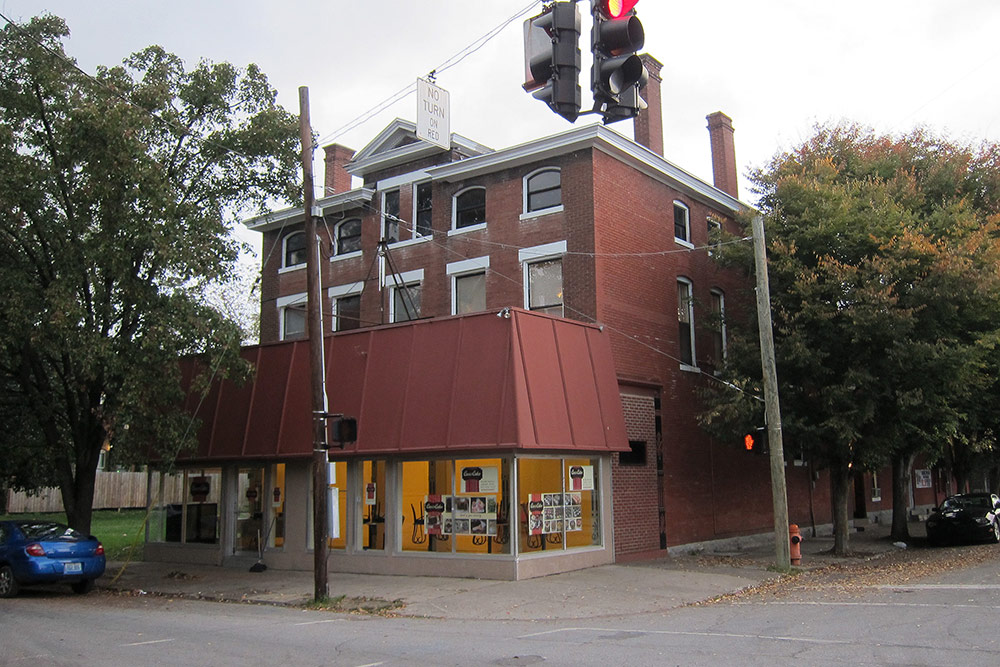
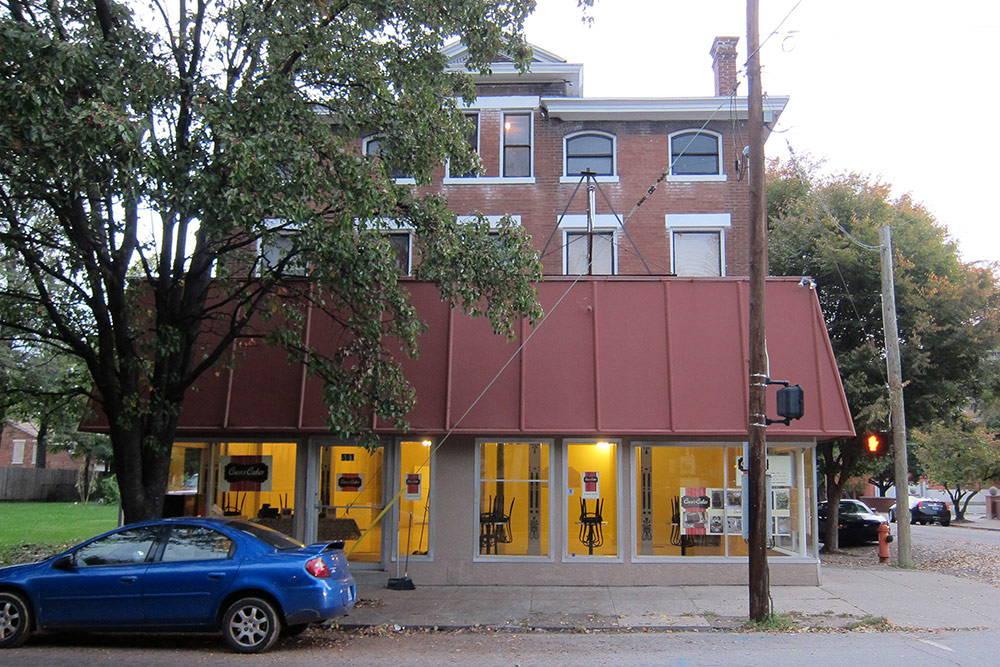


Let Oak Street Girl give you the histo-presto tour some day. 23 years living on the street and ten more just for kicks gives me some cred. But please don’t diss the mid centch corner bank! It could become a gateway corner entry to a different kind of option to fill out the corner. And no, these sidewalks and stick trees basically feed political feel good photo ops but don’t make a viable corridor. (That would mean Fischers MoveDevelopVisionEcon people would actually have to DO something….)
The plague of semi trucks trolling Oak and Old Louisville is a serious serious debacle on the part of transportation planners and DPW who reneged on the promise to reroute trucks via Ninth Street. Some street lighting would also take some of the bite out of this dark street at night..
Great article! I agreed Debra^. What happened to the plan for the trucks! ??!!
My friends and I routinely walked from 15th & Oak (California neighborhood) to Manly Jr. High @ Brook and Oak ions ago. Sure, it was a long walk, but it felt 1/3 the distance because of what stood along the way. As an adult, I have probably lived in Old Louisville longer than anyplace else (25+ years, off and on) , and, being a walker, have trekked its streets almost daily over the years. Oak is a challenge because of the lack of trees and points of interests. I also agree about the trucks and public transportation is far worse than it was 40 years ago. Amazing. That is what Fischers MoveDevelopVisionEcon does not understand. In the absence of contemporary transportation solutions and opportunities for working families to own small businesses and have affordable homes, they resort to pavers and struggling trees and a press release. What a waste of $$ for superficial solutions! They have little respect for the flow and ambience of urban neighborhoods. What they can’t suburbanize, they ignore.
I’ll admit that the mid-century bank isn’t all that bad architecturally, Debra, and you and I both know too many mid-century buildings are being torn down these days. But I’m standing by my opinion that the site (of which it occupies less than half) has a much higher use redeveloped. A larger building would make a better landmark intersection and could act as a visual foil to the church across the street. Old Louisville’s top commercial block can’t be all one-story buildings. I’ll definitely take you up on that tour, though!
All good comments and yes the truck traffic needs to be addressed. It has slowed down since Oak went two-way. My first investment property was a mixed use building at the corner of Brook & Oak and I remember the building vibrating when the trucks would speed by. Oak was basically a one-way funnel to the I-65 entrance ramp at Oak & Floyd. Purchased my first home in the 1300 block of 1st in 1990 and have owned and managed property in the area ever since. Was involved in converting over 100 apartments to condos thereby increasing the number of stakeholders in the neighborhood and that’s what’s needed…more stakeholders in one form or another. The misperceptions tied to Old Louisville also need to be addressed. Maybe a marketing campaign similar to the one that resurrected the bourbon industry!
A transit corridor connecting the Central Business District, Spaulding, Old Louisville, UofL, Churchill Downs and 3rd & Central Ave. which has really become an entertainment district when you factor the baseball and football stadiums seems a no brainer. Worth mentioning is UofL’s 20 acre Belknap Applied Science and Research Park under development at 3rd & Iowa. The $31 million infrastructure improvements and access to the park are underway. Connect all these areas with a good transit system and the neighborhood walk score will dramatically increase!
Back to 4th & Oak. A redeveloped Winn-Dixie parcel would have the greatest impact on the intersection of 4th & Oak. From what I understand the ownership of the Winn-Dixie property has placed such a high value on it’s asset making is prohibitive to redevelop. A developer would also need to assemble parcels out to the corner with different owners who all have varying goals, agendas and expected return on investment. With that said, now would be the best time to coordinate a redevelopment effort to pull all owners into the fold to be part of a greater project incorporating the existing businesses into the development. The financing environment is right. Just need the right plan that will satisfy existing property owners or a price that will buy them out. There are developers looking at it and willing to take on the project.
And now for a little marketing, I have performed a retail analysis for the 4th & Oak area and it was very interesting. One thing it showed was a VERY high need for a specialty grocery & deli in the area. I have a retail building at the corner of Oak & Garvin next to the Family Dollar. We would love to see a neighborhood grocery/deli occupy the space and are talking to some but welcome any suggestions from the neighborhood. Thanks!
I stand by the little bank that could as a one story gateway to something grander. Did you know that the mess behind it was once the Women’s Club building radically designed in the mode of Wright by Mason Maury who converted at the altar and gave us a short lived design boost in 1904? Sadly it burned not long after. Hopefully we will see similar things rising with the Filson expansion, which can only help that other midcentch at Fourth and Liberty. Wasting good structure isn’t green. And I love that little bank, whose entry once faced Fourth, then Oak, then lastly we scootched it to the side where it provides great urinal potential to this day. The bus stops were so bad the bank couldn’t operate street facing entries. Fourth and Oak has had forty plus years to get on somebody’s radar. When you cannot fuel real development you give em sidewalks and still no bus stop on westbound Oak and hope you make it look good fer now. And that’s never been enough to gain traction. The Family Dollar expansion gained no notice, not a single neighborhood person attended the three hearings or even saw an opportunity to design a much better site plan than the 1985 original compromise plan! And the ever knowledgeable city told the developer they had to maintain all that surface parking, creating what has to be the dumbest access for both the handicapped and the able bodied. There is NO parking requirement in the zone. Greg might want to pay attention to the little things that add up to missed opportunity…….caused by people who don’t even know the code they administer.
Instead of wooing every out of state lets build more apartments developer and Cordish, how’s about giving the upcoming areas of Smoketown Shelby Park and the hood some Econ Dev that’s not just another six figure pretty face at ForwardMovePossibilityVisionGreg? There’s real work to be done, and lots of institutional memory to build upon. Having stood on East Oak and literally pushed facades down into the street to reclaim the houses behind, having watched the Long vacant Dance Council building burn and be reborn, having endured 23 years of empty Rumpke trucks hurtling down Oak at 4 am going 60 mph because they could…….yeah. It takes a village and some gutsy moves by local leadership. Gill cannot be everywhere. !
Anybody know what’s going into that KFC-style building closer to Fifth? I see someone working in there every day.
Closer to Sixth, rather.
they got the trees in the wells recently. While the wells are spacious, and have those nice grates to protect the roots, they are really good at collecting litter. Many of them are filling up with difficult to reach trash. I’m hoping there is plan to clean them out regularly.
I miss the trees 🙁